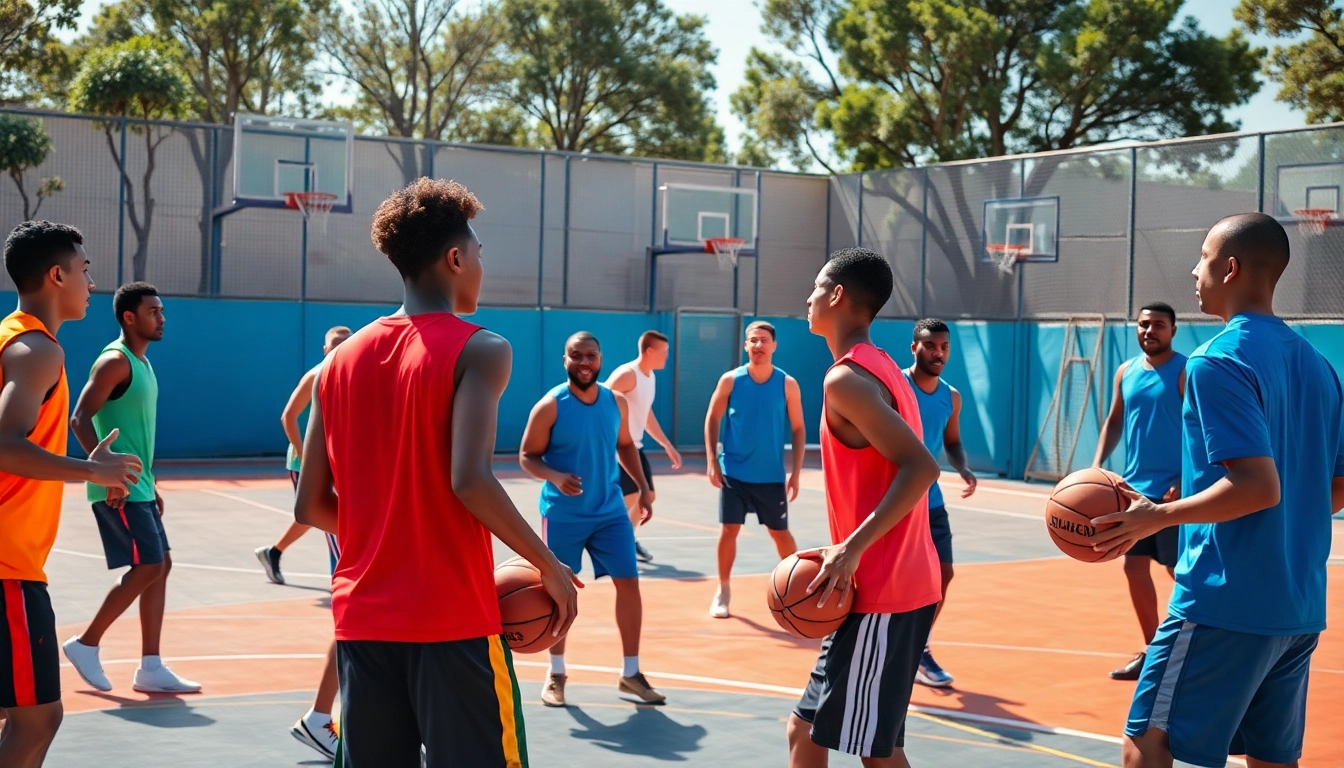Understanding Basketball Training Programs
What Are Basketball Training Programs?
Basketball training programs are structured pathways designed to enhance a player’s skills, knowledge, and overall game performance. These programs encompass a range of activities, from skill drills and conditioning to strategic gameplay practices. They are tailored for players of all levels, from beginners to seasoned athletes, ensuring that everyone can benefit from focused training and development.
Typically, these programs may include in-person coaching, online classes, and self-directed skill-building exercises. They can vary in intensity, duration, and focus, catering to individual or group needs. By integrating various training methodologies, such as shooting drills, ball handling, offensive and defensive tactics, basketball training programs aim to develop well-rounded players capable of performing under pressure.
The Importance of Structured Training
Structured training is crucial for several reasons. First and foremost, it provides players with a clear framework for improvement. Without a defined strategy, players may struggle to track their progress or understand which skills need refinement. Structured programs guide athletes through the essentials of basketball, ensuring they build strong foundational skills before advancing to more complex concepts.
Furthermore, structured training helps in instilling discipline and commitment. Regularly scheduled training sessions encourage players to develop a routine, fostering perseverance essential for athletic success. Participants also benefit from cognitive training, learning the mental side of the sport, such as reading defenses, making strategic decisions during games, and cultivating a competitive mindset.
Different Types of Basketball Training Programs
There exists a diverse assortment of basketball training programs tailored to fit specific needs and experiences:
- Skill Development Programs: Focused on enhancing shooting, dribbling, and passing skills through targeted drills and activities.
- Strength and Conditioning Programs: Designed to improve physical fitness, agility, and endurance to augment on-court performance.
- Position-Specific Training: Targets skills unique to a player’s position (e.g., post moves for centers, shooting drills for guards).
- Team Training Camps: Often held during the off-season, these camps help teams practice together to improve chemistry and strategy.
- Online Training Programs: Combining instructional videos, virtual coaching feedback, and interactive assessments allows players to learn at their own pace.
Evaluating the Best Basketball Training Programs
Key Features of Effective Training Programs
When searching for the best basketball training programs, players and coaches should look for several essential features:
- Experienced Coaching: Programs led by knowledgeable coaches can make remarkably positive impacts on player development.
- Comprehensive Curriculum: Effective programs should address all aspects of the game, including offensive and defensive strategies.
- Progress Tracking: The best programs implement methods for evaluating player development to ensure continual improvement.
- Flexibility and Variety: Adjustable training plans that cater to individual needs are crucial for engagement and effectiveness.
- Community and Support: A supportive training environment that fosters collaboration and encourages peer feedback enhances motivation.
Success Stories and Testimonials
Listening to the success stories of previous participants can illuminate the effectiveness of a basketball training program. Many athletes share transformative experiences, highlighting how rigorous training shaped their abilities and game intelligence. Testimonials can provide insights into the program’s methodologies, coaching styles, and outcomes.
Some renowned programs, such as Hoop Group and Evolution Basketball, showcase a multitude of success stories, suggesting significant improvements in the players’ performance, whether in high school championships, collegiate recruitment, or even professional careers.
Cost-Effectiveness of Popular Programs
While the quality of a basketball training program is paramount, budget considerations also play a crucial role in the decision-making process. Evaluating cost-effectiveness involves comparing program prices with the value provided, including the duration of sessions, coaching quality, and facility access.
Many reputable programs offer a variety of pricing plans, scholarships, or subscription-based online accesses. Assessing these options can help players find affordable, high-quality training, thus maximizing their development potential without financial strain.
Customizing Your Basketball Training Experience
Assessing Your Skill Level
Before diving into any training program, it’s vital to assess your current skill level honestly. This evaluation can be informal, such as self-reflection or gameplay analysis, or formal through skill assessments by coaches. Understanding your strengths and areas needing improvement allows for a more tailored training approach.
Tailoring Programs to Personal Goals
Setting specific, measurable, attainable, relevant, and time-bound (SMART) goals enables players to make the most out of their training efforts. Whether the aim is to enhance shooting accuracy, improve conditioning, or develop better teamwork skills, personalizing the training program around these objectives is essential for effective development.
Finding the Right Training Environment
The environment where training occurs significantly influences a player’s commitment and progress. Factors such as the available facilities, coaching staff, fellow participants, and location all contribute to the experience. Players should seek training facilities that foster a positive atmosphere and where competitive but supportive environments encourage continuous development.
Integrating Technology into Basketball Training
Online vs. In-Person Training Programs
The rise of technology has led to a significant shift in the landscape of basketball training. Online programs offer flexibility, allowing players to learn and practice at their own pace. They can access a wide array of resources and interact with expert coaches via video conferencing. However, in-person training still holds immense value, particularly for hands-on skill development and immediate feedback.
Ultimately, integrating both methods can yield the best results, ensuring balance between independent learning and direct coaching interaction. For players seeking a comprehensive training experience, a hybrid approach can be particularly beneficial.
Utilizing Apps and Video Analysis
Many apps have emerged to assist players in their training endeavors, ranging from workout tracking to skill assessment tools. Apps such as HomeCourt use advanced technology, including AI-driven analytics, to provide players with feedback on their shot mechanics and overall performance metrics. Video analysis is another invaluable tool; having trained professionals break down gameplay footage allows players to understand their play style better and identify areas of improvement.
Tracking Progress with Wearable Technology
Wearable devices such as fitness trackers and heart rate monitors have found a prominent place in modern basketball training. By collecting data on metrics like heart rate, calories burned, and workout intensity, players can fine-tune their training efforts to align with their goals. This data-driven approach helps athletes remain accountable and motivated by visualizing their progress over time.
Maximizing Performance with the Best Basketball Training Programs
Setting Realistic Goals and Objectives
Crafting realistic objectives is a pivotal step in maximizing the benefits of any basketball training program. Athletes should write down their goals, considering their unique circumstances and previous experience. This exercise helps maintain focus and provides a clear roadmap for progress, turning aspirations into achievable milestones.
Balancing Training and Recovery
Physical exertion without adequate recovery can lead to burnout or injuries. Therefore, players need to balance intense training sessions with sufficient rest and recovery to allow muscles to heal and adapt. Many successful training regimens incorporate rest days, active recovery sessions, and periods for mental relaxation, allowing athletes to recharge both physically and mentally.
Maintaining Motivation and Discipline
Staying motivated throughout a training journey can be challenging, especially during periods of slowed progress or when facing tough competition. Players should implement various techniques to maintain their discipline and enthusiasm. Techniques such as establishing a consistent training schedule, celebrating small victories, and seeking motivation from fellow teammates can create a positive feedback loop that fosters sustained growth and improvement.
In conclusion, whether you are a novice player trying to develop your skills or a seasoned athlete aiming to refine your game, exploring best basketball training programs tailored to your needs is essential for achieving excellence on the court. By understanding the various aspects of training – from structured programs and evaluation methods to technological advancements – players can maximize their performance and unleash their full potential.



